Miscellaneous viewing – March 2018
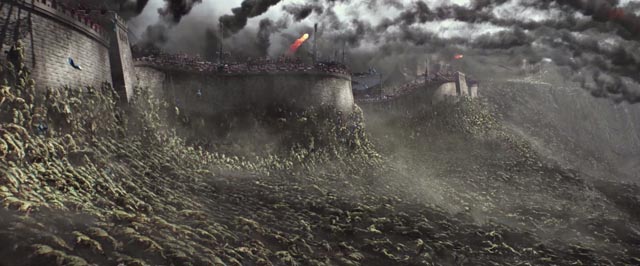
In between the more notable movies I’ve been watching and writing about in the past month or two, I’ve also spent quite a bit of time on a range of genre movies – both high- and low-end. As I’ve no doubt made clear many times before on this blog, I have a deep affection for genre films which makes me tolerant of the shortcomings which frequently afflict them. That said, my tolerance tends to decline in direct proportion to the budget of such movies; if producers are willing to expend vast resources, I believe they should make an effort to get things right, while filmmakers operating on a shoe-string get credit for ambition which exceeds their ability to realize their ideas.
Which is why Zhang Yimou’s The Great Wall ends up more irritating than entertaining. Zhang was one of the key figures in the wave of new Chinese cinema which gained international attention as China began to open up in the 1980s. His career has gone through several phases, beginning with lush historical dramas – Red Sorghum (1988), Ju Dou (1990), Raise the Red Lantern (1991) – followed by stories of more recent events in ordinary Chinese lives – The Story of Qiu Ju (1992), To Live (1994), Not One Less (1999) – and finally a series of large-scale, elaborately colourful martial arts epics which represented a decisive shift towards popular entertainment which not inadvertently reinforced an official desire to create an acceptable view of Chinese history which was supportive of the status quo – Hero (2002), House of Flying Daggers (2004), Curse of the Golden Flower (2006). These latter films helped to give Chinese cinema popular (rather than art house) success in the West; made with consummate skill, they are visually stunning, packed with exciting action, and deeply conservative in their romanticism.
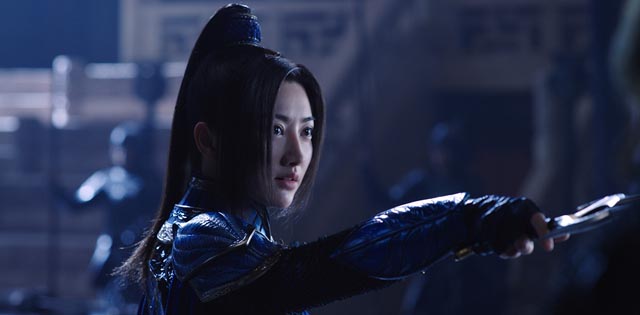
The Great Wall (Zhang Yimou, 2016)
It’s probably not surprising, although perhaps a little sad, that Zhang should have been chosen to helm The Great Wall (2016), a U.S.-China co-production with a huge budget, which was deliberately targeted at an international audience. Dominated by Western stars (Matt Damon, Willem Dafoe, Pedro Pascal), bloated with CGI battle scenes and landscapes, and written by Americans, The Great Wall reduces Chinese history to cartoonish artifice – it has as much to do with China as The Prince of Persia and Gods of Egypt have to do with their titular countries. What Zhang brings to the movie is his flair for colour and the sweeping movement of crowds; unfortunately he’s hampered by a half-baked script (with six credited writers) which is predicated on spectacle rather than narrative coherence.
The problems begin right at the beginning; we’re told that the Great Wall took 1500 years to build, yet it was apparently constructed to keep out a horde of alien monsters which crashed in a meteor (or something) on a particular mountain. This horde attacks every sixty years, and if it manages to breach the Wall, the entire world will be overrun. How the monsters were held at bay during the 1500 years of construction isn’t clear.
As for the monsters themselves, they’ve been cooked up without much effort to make sense of them. (There are echoes, probably unintentional, of The 13th Warrior, but in that film there’s a rationale which grounds the story in a plausibly conceived fantasy version of history.) There are tens or hundreds of thousands of the beasts, but all controlled by a single “queen”; she uses some kind of psychic force to manage them, which we learn can be interfered with by a magnet, a device which proves crucial at the climactic moment.
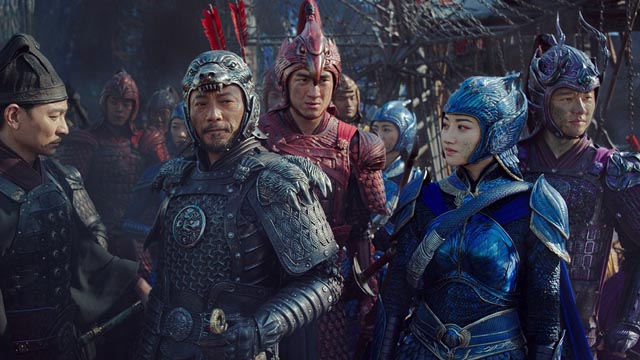
The story centres, however, not on the centuries long fight of an elite corps of warriors to hold back the horde, but rather on a couple of Western mercenaries who have trekked to China in search of the legendary black powder which will revolutionize their business of war back home. Treated with distrust when they arrive at the Wall, needless to say they prove themselves in battle and eventually become the key players in defeating the enemy which the Chinese have been unable to destroy in centuries.
This tosh is given a degree of gravitas by the dignity of the Chinese actors in key supporting roles, particularly Andy Lau and Hanyu Zhang as commanding officers and Tian Jing as the fearless Commander Lin Mae, who thankfully doesn’t quite get drawn into a romance with Matt Damon’s William.
But some committed performances and Zhang’s facility with spectacle can’t overcome the thinness of the conception. All that talent and those resources have been wasted on a deliberate attempt to drag China into the commercial wake of The Lord of the Rings. Perhaps something more worthwhile could have been made with more Chinese talent at the conceptual level.
*
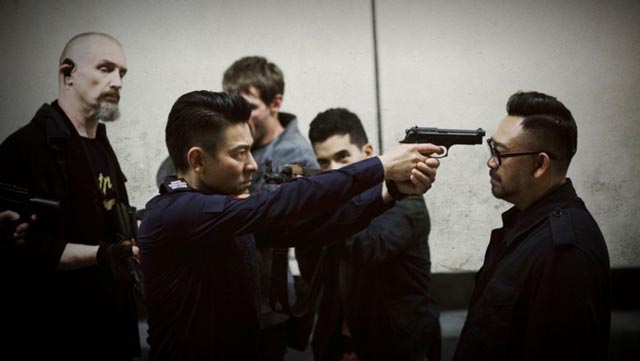
Shock Wave (Herman Yau, 2017)
Andy Lau also stars in Herman Yau’s Shock Wave (2017), a derivative action thriller about a Hong Kong police bomb squad officer faced with a revenge-seeking criminal who begins planting explosives around the city, ostensibly to force the release of his younger brother who was put away by Lau’s Officer Cheung. But mostly he’s doing it all because he’s an evil son-of-a-bitch. Slickly produced, the movie has touches of Die Hard and Speed and any number of other movies, leading to a large-scale protracted final act in which the bad guy traps hundreds of people in one of Hong Kong’s busy harbour tunnels with huge bombs set at either end. He demands money and the release of his brother in exchange for releasing all the hostages, or he’ll explode the bombs (trucks packed with C4 and rigged with complex detonators which make them all-but-impossible to disarm). Inevitably it comes down to a personal confrontation between Cheung and the villain, in which decency and self-sacrifice face off against destructive egotism. Efficient rather than inspired, Shock Wave has far more technical polish than the great HK action movies of the ’80s and ’90s, but partly because of that it lacks their rough charm and energy.
*
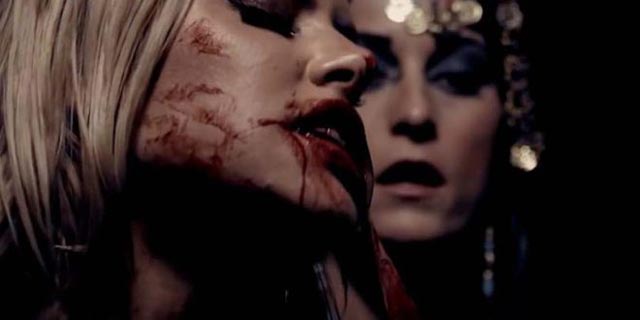
Blood Feast (Marcel Walz, 2017)
Also more polished than its influences, Marcel Walz’s Blood Feast (2017) is both better and somewhat less interesting than Herschel Gordon Lewis’s influential Blood Feast (1963). The story is essentially the same – an Egyptian restaurateur kills a series of people to create a cannibal feast in an effort to reincarnate the goddess Ishtar – although it’s moved from Miami to Paris, where Fuad Ramses (Robert Rusler) runs an American-style diner with his wife Louise (Caroline Williams) and sometime help from their daughter Penny (Sophie Monk). Business isn’t very good and Fuad moonlights as a night guard at a museum where he starts to see visions of Ishtar who gives him cues on what to do. Although it’s kept ambiguous, chances are these are hallucinations brought on by Fuad not taking his anti-psychotic meds (at the start of the movie, he accidentally spills the pills down the bathroom drain, something he hides from his concerned wife).
While Lewis’s movie is almost unwatchably crude, its gore effects (despite being so influential) are totally unconvincing. In Walz’s version, performances are competent and the gore is as good as you’d expect in a contemporary low-budget effort. But paradoxically the new film’s competence strips away the older one’s transgressive appeal. It’s a case of a filmmaker thinking that he can take something of poor quality and do it better, perhaps without realizing that what made the original effective for audiences was just that poor quality; a silly story is here actually diminished by the improvement.
*
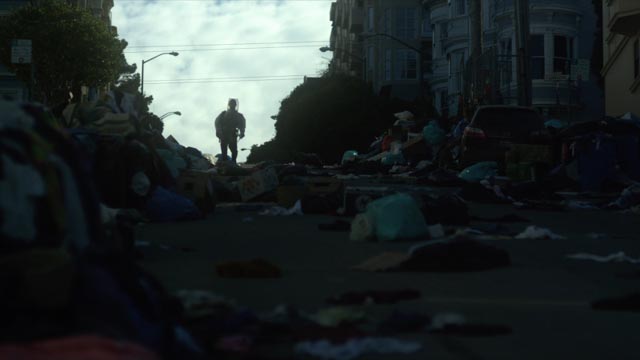
Contagion (Steven Soderbergh, 2011)
I didn’t bother to go see Steven Soderbergh’s Contagion in 2011 because I’d lost interest in him as a filmmaker by that point. The vacuousness of the Ocean’s movies, the travesty of Solaris, the bloated seriousness of his Che two-parter … the filmmaker of King of the Hill, Out of Sight, The Limey and Bubble seemed to have vanished. But I do have a soft spot for plague movies, so when I recently came across a discount copy of the Blu-ray, I decided to take a look. I actually quite liked it. It’s a process movie, working its way through (and serially killing off) a long list of characters played by prominent actors as it tracks a new virus which spreads around the globe and wipes out millions before dedicated scientists and bureaucrats begin to get it under control. Although the characters suffer, the movie itself maintains a cool detachment, drumming up scares about our vulnerability (Soderbergh constantly cuts to close-up details as people touch things unconsciously – doorknobs, railings, coffee cups – passing on or picking up the infection), while simultaneously trying to reassure us that no matter how dire the situation there’s probably a cure.
*
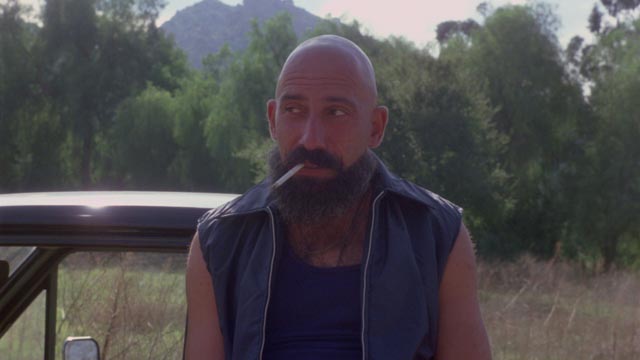
The Aftermath (Steve Barkett, 1980)
With far fewer resources (and notably less talent), Steve Barkett went even further than Soderbergh in devastating the world in The Aftermath. Copyright on the VCI Blu-ray says 1980, but IMDb gives the date as 1982, but either way it feels even older – like the early or mid-’70s. Made on less than a shoestring, it cribs from Planet of the Apes (astronauts return to Earth to find it devastated by a nuclear war), Logan’s Run (Forrest J. Ackerman does a brief bit a la Peter Ustinov as a wise old man who looks after a museum of antiquities and passes on some information to the protagonist). The tone is actually reminiscent of an old Outer Limits episode, though less polished.
Astronaut Newman (writer-producer-director Barkett) and his surviving companion encounter cannibal mutants and set up in a hillside mansion, then wander around (the companion disappears for long stretches, suggesting that the actor wasn’t always available when there was enough money to grab a day or two of shooting). Newman is handed a young boy by the Curator before the latter wanders off to die, and then encounters Sarah (Lynne Margulies), a woman on the run from a marauding gang which gets its kicks from raping and murdering what few survivors are left. But this ersatz family is not destined to last once the gang catches up with them. Adding to the ’70s ambience is a bleak ending which leaves little hope for the future.
The clunky script and uninspired direction are offset slightly by some fairly effective matte shots and miniatures which provide views of a devastated city and the always-reliable presence of Sid Haig as the cheerfully sadistic gang leader. VCI’s disk features a 2K scan from the original negative (showing its age) and some interviews, plus a commentary track from Barkett, and Night Caller (1973), an earlier short in which he starred, a Ray Bradbury adaptation directed by Dan Gilbert which has a similar post-apocalyptic premise.
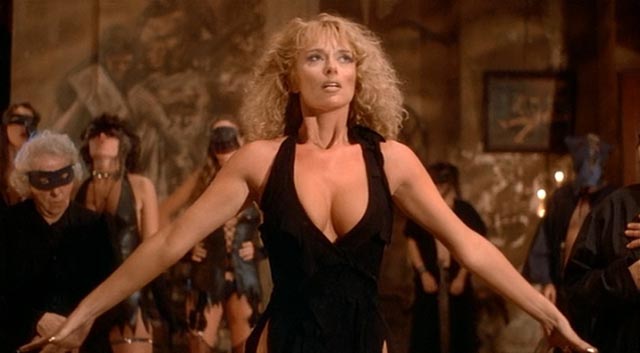
Howling II: You Sister is a Werewolf
(Philippe Mora, 1985)
I have a bit of a soft spot for Australian director Philippe Mora, although a quick glance at his IMDb listing shows that I haven’t actually seen most of his movies, and the few I have seen from his post-’70s work are engaging more for their essential dumbness than anything else. But he made two films in the mid-’70s which stand out as the work of a committed and original filmmaker. Swastika (1974) is a risky documentary which uses Nazi propaganda films to present the image Germans had of themselves as they lived under Hitler and his crew, a portrait of a happy and optimistic population getting on with their lives under the benevolent eye of Der Fuhrer. But if that wasn’t enough, Mora also had access to newly discovered colour home movies shot by Eva Braun at Hitler’s retreat at Berchtesgaden, images of Der Fuhrer relaxing, enjoying the company of Nazi officials and groups of happy children and dogs. The sheer banality of these images is what is most disturbing about the film – and the reason it was banned in a number of countries, and remained largely unseen for decades until released on DVD (by Umbrella in Australia in 2006 and in the U.S. by Kino Lorber in 2012) with substantial contextual extras. Mora’s film was accused of normalizing Hitler and the Nazi regime and that may well have been a danger – neo-Nazis could no doubt use it to claim that the horrors were all cooked up by Germany’s enemies. And yet Swastika was obviously made with the understanding that its audience would already be well aware of the context; its purpose was to indicate how the population of a nation involved in committing the worst crimes against humanity imaginable did not consider itself evil. An obvious point, perhaps, but one that often gets lost when we protect ourselves by “othering” those we want to distance ourselves from.
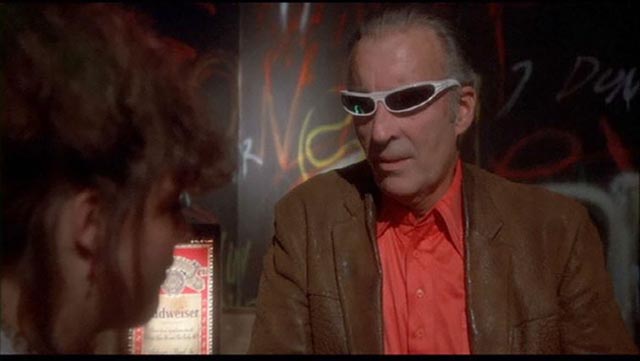
Mora followed this documentary up two years later with one of the (still largely unacknowledged) masterpieces of the Australian New Wave, Mad Dog Morgan (1976), an Aussie “western” based on the life of outlaw Daniel Morgan (a fine Dennis Hopper). Issues of race and class permeate this story of an outsider who offended a corrupt, oppressive society. This is such a strong, visually assured film that it seems puzzling that Mora didn’t go on to achieve the status of such contemporaries as Peter Weir, Bruce Beresford, Fred Schepisi and Gillian Armstrong. But for some reason, it was followed by a six year gap before he resurfaced in the U.S. with a dumb horror movie called The Beast Within (written by Tom Holland, who quickly went on to bigger things with Class of 1984, Fright Night and Child’s Play), which in effect transfers Hammer’s Curse of the Werewolf to contemporary rural Mississippi, in the process changing the werewolf to a were-cicada.
Mora’s most interesting later movie is the eccentric, not to mention wacky, Communion (1989), adapted from Whitley Streiber’s account of his own history of alien abductions, but his most entertaining movies of the ’80s are probably the pair of sequels he made to Joe Dante’s The Howling (1981). Dante, working from John Sayles’ script, laced his film with humour, giving this tale of a werewolf cult in California a satirical edge while expanding the possibilities of practical effects (courtesy of Rob Bottin). The first sequel, Howling II: Your Sister is a Werewolf (1985) was co-scripted by original author Gary Brandner himself, based on his own novel, and nothing makes clearer Sayles’ contribution to the original film. The sequel is a frequently silly B-movie, shot quickly in the Czech Republic. Although it begins where the first film ended – with the funeral of Karen White (shot on live TV as she transformed into a cute were-puppy), at which a brooding Christopher Lee approaches Karen’s brother Ben (Reb Brown) to warn him that yes indeed Karen was a werewolf and that the curse stems from a cult in Eastern Europe – it feels completely unconnected in tone, style and the general quality of the filmmaking.
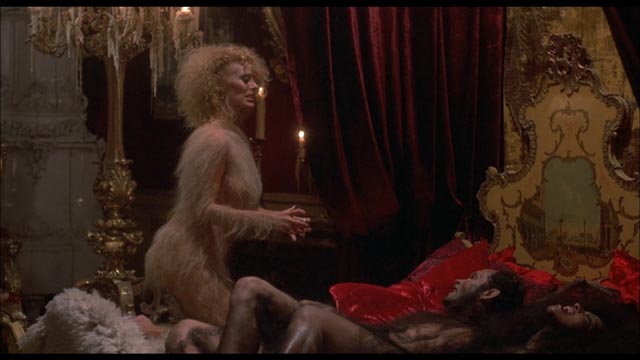
After some brief resistance, Ben and Karen’s friend Jenny (Annie McEnroe) head for the Old Country to put an end to the cult before ancient were-queen Stirba (Sybil Danning) regains her full powers and the monsters take over the world. Although the Czech locations add some value, there’s not a lot of atmosphere and no-one seems to be taking any of it seriously (unlike everyone involved with the original film). What results is a mildly entertaining drive-in movie, on which Shout Factory lavished a surprising amount of attention for their 2015 Blu-ray release which has a decent transfer, two commentary tracks and three interview featurettes.
Mora returned to this well two years later, with better results if only because he indulged a penchant for the absurd which was constrained in the previous movie. Returning to Australia for Howling III: The Marsupials (1987), and writing the script himself, he came up with a hilariously over-the-top story about a parallel race of, yes, marsupial werewolves. But for whatever reason, he has never again made anything as daring as Swastika or as fully-realized as Mad Dog Morgan.
Comments